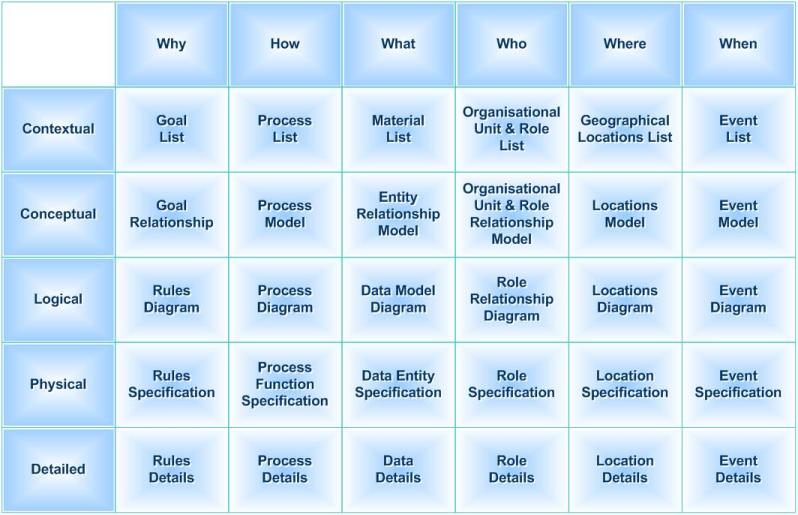
Zachman Framework Overview
What is Zachman Framework?
The Zachman Framework is a structure for enterprise architecture that helps in organizing the design artifacts created during the development of an enterprise system. Developed by John A. Zachman in the 1980s, it provides a schematic and systematic representation that defines and classifies the elements of an organization’s architecture.
The framework consists of a 6×6 matrix, where the rows represent different stakeholders’ perspectives, and the columns represent the key questions that must be addressed. The intersection of a row and column in the matrix is a specific architectural artifact, and together they create a holistic view of the enterprise.
Who is John Zachman, and How did the Framework Evolve?
John A. Zachman is a renowned pioneer in the field of enterprise architecture. He started his career at IBM, where he became aware of the complexity associated with large-scale systems design. Through his observations and research, he conceptualized the Zachman Framework.
Initially published in the IBM Systems Journal in 1987, the framework has evolved over time, with modifications and adaptations to address the growing complexity of modern enterprises. Its inception marked a significant shift in thinking about organizational design, allowing a more structured and systematic approach.
Describe the Scope of Zachman
The scope of the Zachman Framework is vast, encompassing the entire organization’s architecture. It covers aspects ranging from the high-level conceptual view down to detailed specifications and implementations. The six perspectives within the framework represent different stakeholders:
- Executive (Scope): Defines the business’s boundaries.
- Business Management (Business Concepts): Analyzes the business’s processes and functions.
- Architect (System Logic): Designs the system’s logic and data flow.
- Engineer (Technology Physics): Translates the logical design into technology specifics.
- Technician (Component Assemblies): Details the construction.
- Enterprise (Operations Classes): Describes the functioning system.
Why does one need an Enterprise Architecture Framework?
Enterprise Architecture Frameworks like Zachman provide a systematic approach to aligning IT with business objectives. They allow for:
- Coherence: Ensuring alignment and consistency across different departments.
- Integration: Facilitating integration between various systems and technologies.
- Optimization: Supporting continuous improvement and optimization of processes.
- Strategic Planning: Assisting in long-term strategic planning and development.
How can Enterprise Architects Use Zachman for creating and managing Enterprise Architecture?
Enterprise Architects use the Zachman Framework to analyze and create a comprehensive blueprint of the organization. By systematically mapping out the architecture using the matrix, they can:
- Visualize Complex Systems: It allows for a clear visualization of the relationships and dependencies within the organization.
- Facilitate Collaboration: It enables collaboration between different stakeholders by providing a common language and understanding.
- Enable Flexibility: It provides a structured yet flexible approach to enterprise architecture, adapting to organizational changes.
What are the benefits of using Zachman?
- Standardization: Promotes a standardized approach to understanding and building enterprise architecture.
- Communication: Improves communication between different stakeholders.
- Risk Mitigation: Helps in identifying potential risks and addressing them proactively.
What are the criticisms of Zachman?
Despite its advantages, the Zachman Framework has faced some criticism:
- Complexity: The 6×6 matrix can be overwhelming and complex to use.
- Lack of Practical Guidance: Some critics argue that the framework is too theoretical and lacks concrete implementation guidance.
What are the alternative Enterprise Architecture Frameworks?
Other popular enterprise architecture frameworks include:
- TOGAF (The Open Group Architecture Framework): A detailed and flexible framework.
- FEAF (Federal Enterprise Architecture Framework): Specific to U.S. federal agencies.
- DoDAF (Department of Defense Architecture Framework): Used by the U.S. Department of Defense.
In conclusion, the Zachman Framework is a critical tool in modern enterprise architecture, providing structure and clarity. It has played a significant role in shaping the way organizations plan, design, and implement their systems and processes. However, like any tool, it must be understood and applied correctly to realize its full potential, and there are alternatives to consider depending on specific organizational needs and preferences.


